China becomes a great naval power.
Initially, China ordered ships and submarines in Russia, for example, on the basis of the Soviet submarine project 877ECM “Halibus” (Export Capitalist Modernized); the 636 “Varshavyanka” project was developed for the Chinese Navy. The main focus of modernization was on ensuring the operation of the mechanisms of the submarine in the tropics. The People's Republic of China supplied the 4 destroyers of the 956 type project “Modern”.
The Chinese have learned a lot from the naval heritage of the Soviet Union (from Russia and Ukraine), including their first "training" aircraft carrier. 4 small landing craft of the 12322 Zubr project (2 should be built in the People's Republic of China) were ordered for China in Ukraine.
Currently, the Chinese have made great progress in shipbuilding and build ships almost completely independently, only part of the systems are ordered abroad (for example: gas turbines, electronic equipment, some weapons). Their success in shipbuilding is based on the brilliant successes in the economy, in 2010, Beijing became the largest country in the world in terms of civil shipbuilding. Much work has been done and is being done in the development of coastal infrastructure - ports, berths, shipyards, etc.
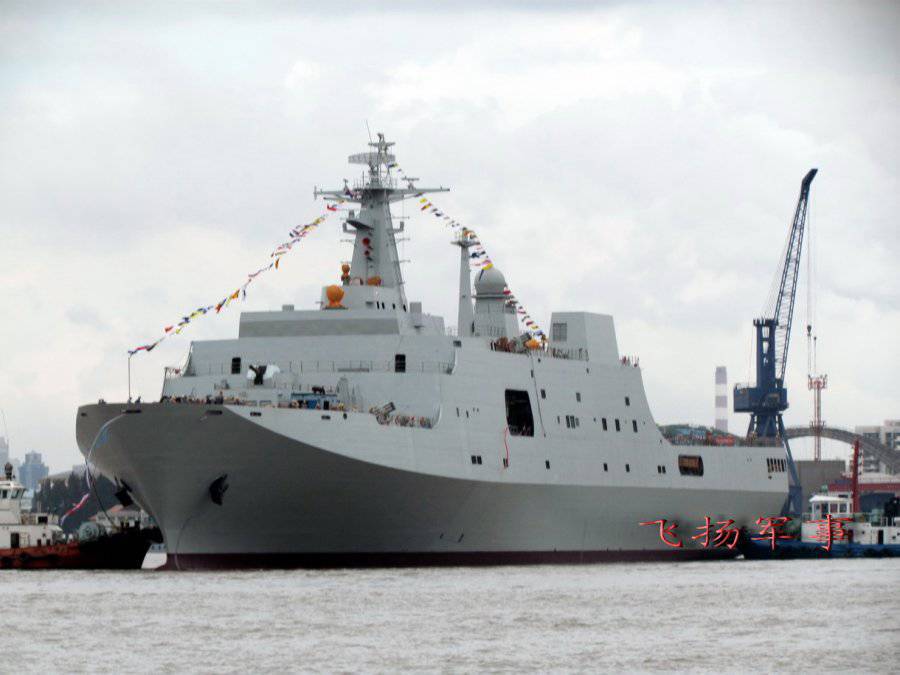
UDC of type “Qinchenshan”, pr. 071.
Strategy
The Chinese Navy has existed since 1949 and is divided into three fleets: the Northern (with its headquarters in Qingdao), the Eastern (with its headquarters in Ningbo) and the Southern (with its headquarters in Zhanjiang). The number, according to 2008 of the year, is 250 thousand people, with a reserve of 600 thousand people. In 1995, the Naval Doctrine of the PLA Navy was officially proclaimed. This doctrine was based on the “Active Defense Strategy”, which envisaged the creation of the Navy and the Air Force supporting them, capable of not only repelling enemy aggression from the sea, but also delivering preventive strikes, including in the ocean theater of operations. At the same time, a statement was made that at the first stage (up to 2000 of the year), Beijing plans to create naval groups capable of maintaining a favorable operational regime within the coastal zone. This zone is limited to the so-called. “The first chain of islands” is the Ryukyu Islands and the Philippine Islands, and in the waters of the “Chinese seas” - the Yellow, East China and South China seas. Basically, China has achieved this step and moved on to the next.
At the second stage of naval construction (up to 2020 of the year) it was planned to strengthen the country's naval forces so that they could carry out successful operational activities within the limits of the so-called. The “second chain of islands” includes the Kuril Islands, Hokkaido Island, Nampo Islands, the Mariana Islands, the Caroline Islands and the island of New Guinea. This zone includes the waters of the Japanese and Philippine Seas, as well as the seas of the Indonesian archipelago.
At the third stage (up to 2050 of the year), Beijing intends to create a powerful ocean fleet that will be able to solve assigned tasks in any area of the World Ocean. That is, this is the level of the current US Navy.
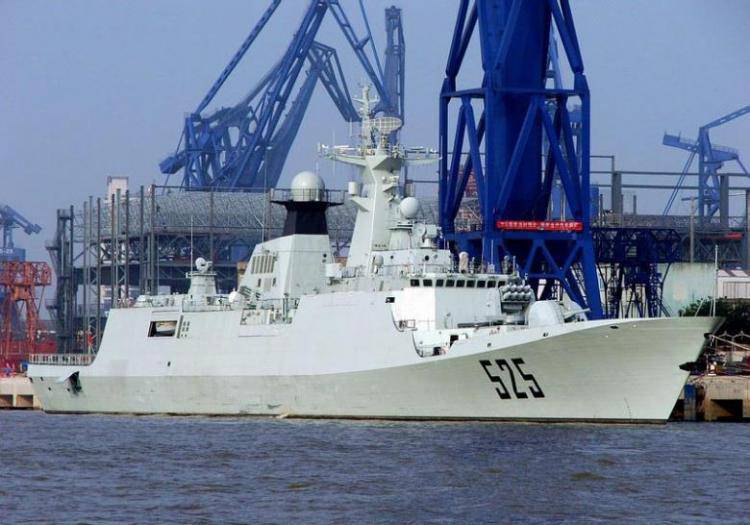
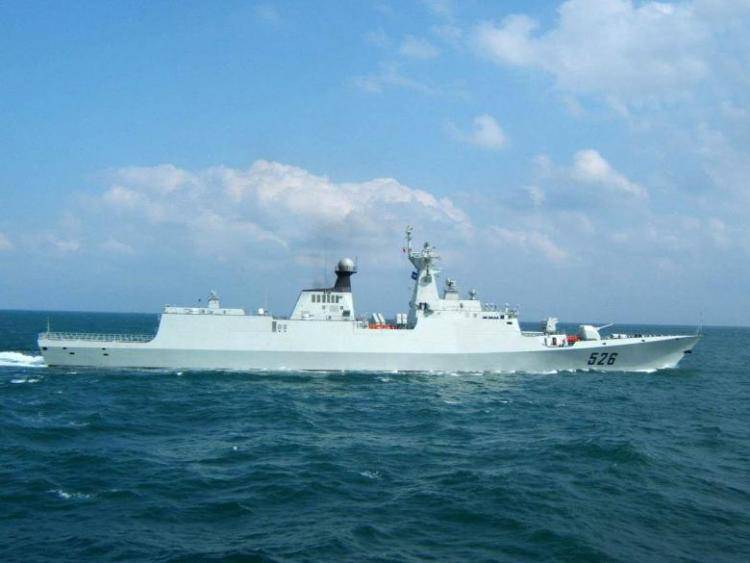
Frigate URO Ave 054.
Shipbuilding
In 1982, during the first stage of Chinese economic reforms, in China, the 6 Machine Building Directorate, which united the shipbuilding industry, transformed into a single China State Shipbuilding Corporation (China State Shipbuilding Corporation - CSSC), it began to work on a commercial basis. This made it possible to maintain a fairly high-quality management and prevent the industry from splitting into separate enterprises. In 1999, this corporation was divided on a territorial basis into two powerful state-owned companies - retaining the old name China State Shipbuilding Corporation (CSSC), which began to control the shipbuilding industry in the southern part of the state, and China Shipbuilding Industry Corporation (CSIC), to which the enterprises of the northern zone moved.
CSIC has its headquarters in Beijing and unites up to hundreds of enterprises, research institutes, research laboratories with 300 thousand staff. The total shipbuilding power is estimated at 7 million register tons per year. The main shipbuilding center is located in Dalian - - Dalian Shipbuilding Industry Company (Group).
CSSC has its headquarters in Shanghai and unites up to fifty enterprises and research institutes. With its main shipyards in Shanghai and Guangzhou, CSSC also includes a leading Chinese marine design and research institute Marine Design & Research Institute of China (MARIC). Up to 150 thousand people work in the corporation. This company, although inferior in the number of employees, is the largest shipbuilder in China. By 2015, the CSSC management plans to become the leader in the world shipbuilding (in 2010 they were the third).
There are quite a few small shipyards in China, enterprises that are not part of these two corporations. In total, in 2009, in China, there were 1242 shipbuilding enterprises.
Already in 1994, China became the third shipbuilding power in the world, second only to South Korea and Japan. In the 2009 year, the Chinese overtook the Japanese in terms of the number of ships built and took second place, and in the 2010 year the South Koreans. From 2003 of the year to 2010, the total tonnage of maritime commercial vessels with a tonnage of more than 100 registered tons (RT) built in China increased almost 10 times (from 3,763 million RT to 36,239 million RT), and the number almost 7 times (from 203 to 1402 ships). In 2010, China built 37,7% of the tonnage of all ships built on the planet. According to Chinese data, in 2008, China built 2385 vessels of all types, including small river and warships.
Interestingly, in China, most large ships build for export - 70% or more percent.
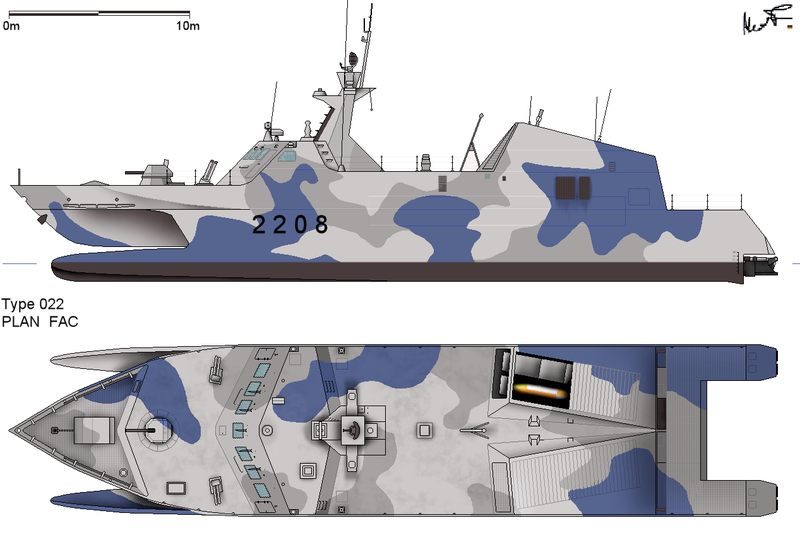
022 project missile boat
Military sector
The military sector is also experiencing a big boost: almost all classes of surface ships are being built, new submarines are being built at a rate of up to 4 submarines a year, new submarines are being designed and built, and the program for creating Chinese atomic aircraft carriers has been launched. Mass construction of more and more sophisticated frigates, amphibious ships, rocket boats continues. So, in the 2004 year, the lead rocket boat of the 022 project was introduced - this is the world's first catamaran with anti-ship missiles. It is built using stealth technology, it is planned to build more than 80 of such boats.
The head samples of fundamentally new types of universal amphibious assault ships-helicopter carriers (UDC type "Qinchenshan", 071 Ave), minesweepers and auxiliary vessels appeared.
In 2003-2005, the first Chinese ships with the Aegis system were built - with highly integrated combat systems, a multifunctional radar with a phased array and the installation of a vertical missile launch. The 052Cs of the Lanzhou type 8 modules of the Chinese HNQX9 vertical launch launcher of the Chinese 6 development of 48 anti-aircraft missiles each, just 300 missiles (this is a copy or Chinese refinement of the Soviet anti-aircraft missiles of the C-054F / Reef complex) were installed on destroyers of the Lanzhou type. This allowed to begin the elimination of a serious shortage of the Chinese Navy - weak air defense. They reinforce the air defense of the ship groups and the frigates of the JI of XJUMX type Jankai (11 units), they are armed with an 32-cell vertical launch system for anti-aircraft missiles - this is a modernization of the 9K37XXNNXX-1 naval air defense system “Shit” for the medium radius of the radius of the radius of the radius of the radius of the radius of the radius of the 2 Jiankyi type Jiangai’s Jankai type fighters. surface targets of the Russian development.
Currently, the Chinese Navy has already reached the 1-e place in the world in terms of the number of combat units, however, so far these are mostly small ships and boats. By the number of destroyers, frigates and submarines, China is second only to the United States. Although so far, in terms of the combat potential of the Chinese Navy, they are inferior not only to the US Navy, but also to the Russian Navy - in terms of the number of nuclear submarines, the number of supersonic anti-ship missiles, and high-tech potential. China needs to develop naval air defense, anti-submarine defense, there are problems with armaments, radio electronic equipment. But this gap is rapidly narrowing.
The main objectives of the Navy: the protection of the coast (there are located the most developed provinces of the country); protection of sea routes (through them goes the main part of natural resources); the possibility of blocking Taiwan and landing operations to seize the island.
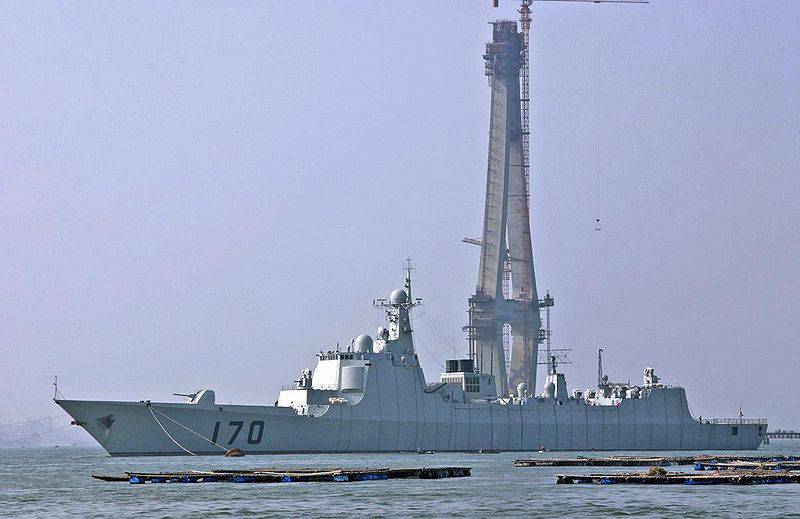
Destroyer type 052C
Information